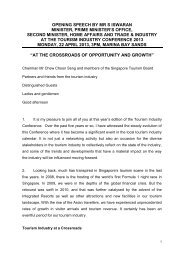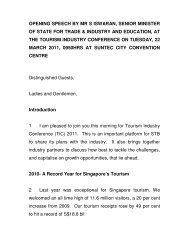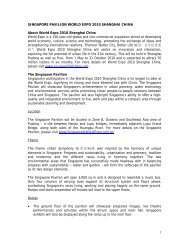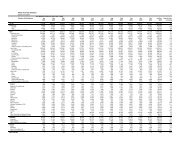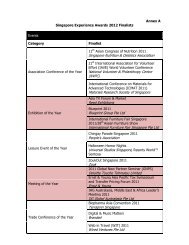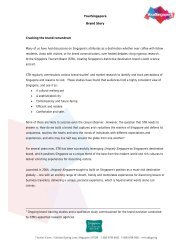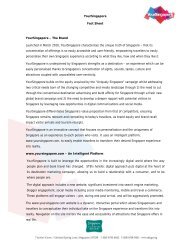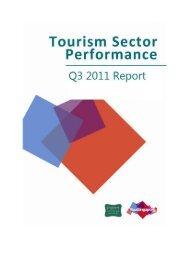i'mpact Singapore Tourism Board Annual Report 2010/2011
i'mpact Singapore Tourism Board Annual Report 2010/2011
i'mpact Singapore Tourism Board Annual Report 2010/2011
Create successful ePaper yourself
Turn your PDF publications into a flip-book with our unique Google optimized e-Paper software.
NOTES TO THE FINANCIAL STATEMENTS<br />
31 March <strong>2011</strong><br />
(h)<br />
IMPAIRMENT OF NON-FINANCIAL ASSETS<br />
At the end of each reporting period, STB reviews the carrying amounts of its assets to determine whether there is any<br />
indication that those assets have suffered an impairment loss. If any such indication exists, the recoverable amount of the<br />
asset is estimated in order to determine the extent of the impairment loss (if any). Where it is not possible to estimate the<br />
recoverable amount of an individual asset, STB estimates the recoverable amount of the cash-generating unit to which the<br />
asset belongs.<br />
Recoverable amount is the higher of fair value less costs to sell and value in use. In assessing value in use, the estimated<br />
future cash flows are discounted to their present value using a pre-tax discount rate that reflects current market assessments<br />
of the time value of money and the risks specific to the asset.<br />
If the recoverable amount of an asset (or cash-generating unit) is estimated to be less than its carrying amount, the carrying<br />
amount of the asset (or cash-generating unit) is reduced to its recoverable amount. An impairment loss is recognised<br />
immediately in income or expense.<br />
Where an impairment loss is subsequently reversed, the carrying amount of the asset (or cash-generating unit) is increased<br />
to the revised estimate of its recoverable amount, but only to the extent that the increased carrying amount does not<br />
exceed the carrying amount that would have been determined had no impairment loss been recognised for the asset (or<br />
cash-generating unit) in prior years. A reversal of an impairment loss is recognised immediately in income or expense.<br />
(i)<br />
PROVISIONS<br />
Provisions are recognised when STB has a present obligation (legal or constructive) as a result of a past event, it is probable<br />
that STB will be required to settle the obligation, and a reliable estimate can be made of the amount of the obligation.<br />
The amount recognised as a provision is the best estimate of the consideration required to settle the present obligation<br />
at the end of the reporting period, taking into account the risks and uncertainties surrounding the obligation. Where a<br />
provision is measured using the cash flows estimated to settle the present obligation, its carrying amount is the present<br />
value of those cash flows.<br />
When some or all of the economic benefits required to settle a provision are expected to be recovered from a third party,<br />
the receivable is recognised as an asset if it is virtually certain that reimbursement will be received and the amount of the<br />
receivable can be measured reliably.<br />
(j)<br />
SHARE CAPITAL<br />
Pursuant to the Financial Circular Minute (“FCM”) No. 26/2008 on Capital Management Framework (“CMF”), equity<br />
injection from the Government is recorded as share capital.<br />
71





